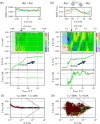Thermoelectricity of near-resonant tunnel junctions and their relation to Carnot efficiency
- PMID: 33479391
- PMCID: PMC7820355
- DOI: 10.1038/s41598-021-81466-3
Thermoelectricity of near-resonant tunnel junctions and their relation to Carnot efficiency
Abstract
We present a conceptual study motivated by electrical and thermoelectrical measurements on various near-resonant tunnel junctions. The squeezable nano junction technique allows the quasi-synchronous measurement of conductance G, I(V) characteristics and Seebeck coefficient S. Correlations between G and S are uncovered, in particular boundaries for S(G). We find the simplest and consistent description of the observed phenomena in the framework of the single level resonant tunneling model within which measuring I(V) and S suffice for determining all model parameters. We can further employ the model for assigning thermoelectric efficiencies [Formula: see text] without measuring the heat flow. Within the ensemble of thermoelectric data, junctions with assigned [Formula: see text] close to the Carnot limit can be identified. These insights allow providing design rules for optimized thermoelectric efficiency in nanoscale junctions.
Conflict of interest statement
The authors declare no competing interests.
Figures





References
Grants and funding
LinkOut - more resources
Full Text Sources
Other Literature Sources

